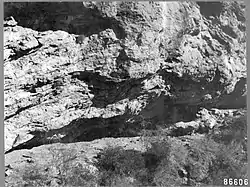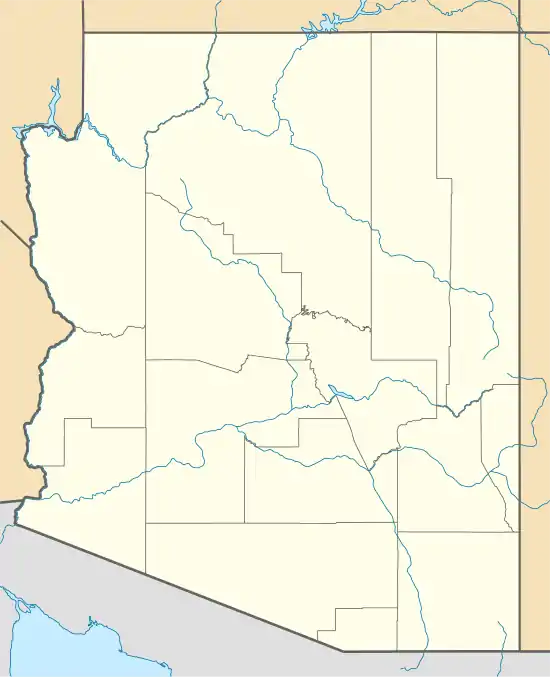| Skeleton Cave | |
|---|---|
 Skeleton Cave located in Salt River Canyon | |
| Location | Salt River Canyon Wilderness |
| Coordinates | 33°34′53″N 111°22′07″W / 33.58136°N 111.36858216°W |
| Entrances | 1 |
Skeleton Cave Massacre Site | |
 Location in Arizona  Location in United States | |
| Nearest city | Apache Junction, Arizona |
| Area | 2 acres (0.81 ha) |
| Built | 1872 |
| Architectural style | Natural Cave |
| NRHP reference No. | 91000100[1] |
| Added to NRHP | February 21, 1991 |
Skeleton Cave is a cave in Maricopa County, Arizona, United States. The cave is within the Salt River Canyon Wilderness and is located on the northern wall of the Salt River Canyon near the Horse Mesa Dam. It was the site of the 1872 massacre of the Yavapai people in the Battle of Salt River Canyon.
It was listed on the National Register of Historic Places in 1991.[2]
Background
A short distance from Canyon Lake, Skeleton Cave, also known as Apache Cave and Skull Cave, is a rock shelter formed by the overhang in the cliff wall.[3] The cave is no deeper than 40 feet (12 m), and is approximately 118 feet (36 m) wide.[3] It sits 1,200 feet (370 m) above the river, at the base of a 170 feet (52 m) cliff.[4]
The cave was used by the Yavapais as a hideout from George Crook and the 5th Cavalry.[5] On December 28, 1872, Crook and his soldiers massacred the Yavapais. This was the first principal engagement during the 1872 Tonto Basin Campaign and part of the 1871 to 1875 Yavapai War.[4] The 5th Cavalry left the more than seventy bodies of the victims in the cave. From the time of the 1872 massacre[5] until about 1905, the cave remained forgotten.[3]
In January 1908, local rancher Jack Adams visited the cave with a group of friends. The remains of the slain Yavapais were still in the cave along with remnants of their belongings, and this is how the cave acquired its name.[6] After 1908, with the construction of local dams, the cave was rediscovered and subsequently looted. In 1933, the remains of the massacre victims were relocated to Fort McDowell.[3]
The wilderness area around the cave is managed by the United States Forest Service. Accessing the cave requires a difficult hike.[7]
Further reading
- Ferg, Alan; Tessman, Norm (1998). The Mortal Remains of Ethnicity: Material Culture and Cultural Identity at Skeleton Cave. Tucson, Arizona: S.R.I Press.
{{cite book}}:|work=ignored (help)
References
- ↑ "National Register Information System". National Register of Historic Places. National Park Service. November 2, 2013.
- ↑ "Skeleton Cave Massacre Site". National Register of Historic Places. National Park Service. Retrieved December 27, 2019.
- 1 2 3 4 Block, Kathy. Du Shane, Neal (ed.). "Skeleton Cave Massacre Site". American Pioneer & Cemetery Research Project. Retrieved December 29, 2019.
- 1 2 "Salt River Canyon, Arizona Battlefield". legendsofamerica.com.
- 1 2 "Dec. 28, 1872: Skeleton Cave Massacre". Zinn Education Project. Retrieved December 28, 2019.
- ↑ Bangs, Daniel; Bangs, Joseph; Bangs, Donald (February 1959). Skeleton Cave.
{{cite book}}:|work=ignored (help) - ↑ "Skeleton Cave, AZ". Hike Arizona. Retrieved December 28, 2019.
External links
- Whitley, Claire (September 6, 2018). "Massacre at Skeleton Cave: A four-hour battle turned into 54 dead Yavapai Native Americans". Verde Valley Newspapers, Inc.
- Salt River Cave Massacre: Skeleton Cave Explored (part 1 of 2) - Beau Ouimette aka Aquachigger on YouTube
- Salt River Cave Massacre: Skeleton Cave Explored (part 2 of 2) - Beau Ouimette aka Aquachigger on YouTube